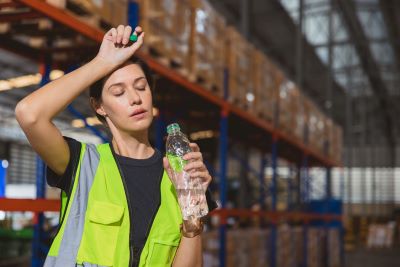Back to Basics is an article series that highlights important but possibly overlooked information facilities management professionals should know.
June is National Safety Month, and in this month’s Back to Basics, we look at workplace heat safety—a major concern not only for those working outdoors but also for indoor workers in facilities with lots of heat.

What Types of Indoor Facilities Get Too Hot?
According to the Occupational Safety and Health Administration (OSHA), indoor areas that can have a lot of heat include bakeries, kitchens, laundromats, other sources with indoor heat-generating appliances, rooms with electrical utilities (specifically boiler rooms), fire service areas, iron and steel mills, foundries, warehouses, and manufacturing facilities with hot local heat sources like furnaces that make paper products or concrete.
Some of these indoor facilities aren’t climate-controlled, and others have nonfunctional air conditioning due to mechanical issues, as the heating, ventilation, and air conditioning (HVAC) system might have issues keeping up with sustained heat inside or outside.
Companies should also monitor their local weather forecast on the National Weather Service (NWS) website so they can be prepared when their region is under an excessive heat warning, an excessive heat watch, a heat advisory, or an excessive heat outlook.
How Hot Is Too Hot?
When the workload is very heavy, OSHA says that heat-related illnesses can occur at temperatures below 65° F but are more frequent when temperatures are 80° F or higher.
Heat-related illnesses are also dependent on an individual’s heat exposure, which is determined by several other factors, including:
- Physical activity
- Humidity
- Air movement
- Heat sources
- Clothing
- Medical conditions
The Natural Resources Defense Council (NRDC) described a restaurant kitchen that reached 102° F when there was no working air conditioning system.
“Sometimes people think that if people are working indoors, they are going to be protected from heat conditions. Sadly, that’s really not the case,” Tim Shadix, legal director for the Warehouse Worker Resource Center (WWRC), told the NRDC.
How Is Heat Dangerous?
According to OSHA, thousands of people get sick from occupational heat exposure each year, and some die because of it. This happens because most workers are performing physical labor while it’s hot.
Common heat-related illnesses and their symptoms include:
- Heatstroke: confusion, slurred speech, loss of consciousness, and seizures
- Heat exhaustion: fatigue, irritability, thirst, nausea or vomiting, and dizziness or lightheadedness
- Heat cramps: muscle spasms, usually in the legs, arms, or back
- Heat syncope: fainting and dizziness
- Heat rash: clusters of red bumps on the skin, often seen on the neck, upper chest, and skin folds
- Rhabdomyolysis (muscle breakdown): muscle pain, dark urine, and weakness
How to Protect Yourself from the Heat
“It’s pretty simple: The harder someone works, the hotter they get,” Dr. Robert Harrison, a physician specializing in occupational and environmental medicine at the University of California, San Francisco, told the NRDC.
“This is not rocket science. Rest, water, and cooling or shade are the three critical elements that can prevent work-related heat illness,” he explained.
Additionally, the National Institute for Occupational Safety and Health (NIOSH) recommends that workers gradually build up to heavy work and schedule it during the coolest part of the day.
How Can Facilities Be Cooled Down?
Facilities managers should work with their organizations to ensure HVAC systems are functioning properly.
Proper maintenance should also be followed, which includes checking and changing air filters, inspecting vents and ductwork, calibrating thermostats, installing new smart thermostats, inspecting insulation, checking the building’s envelope, and making necessary improvements.
The U.S. Office of Energy, Efficiency, and Renewable Energy recommends that facilities professionals check to see if there’s an emergency or a backup air conditioning system and whether the system applies to only one zone or the whole facility. Additionally, they should consider a microgrid solution.
How Can People Be Cooled Down?
If workers develop a heat-related illness, call 911 immediately.
While waiting for medical professionals to arrive, OSHA recommends taking the following steps:
- Take the worker to a cooler area.
- Cool the worker using cold water.
- Remove outer layers of clothing.
- Place cold, wet towels around the head, neck, and back.
- Use fans to circulate air around the worker.
- Never leave the worker alone.
Is There a Heat Standard?
While OSHA is moving forward on a federal heat exposure standard, it currently has a voluntary National Emphasis Program (NEP) for heat-related hazards to encourage employers to help prevent illnesses and deaths by giving employees water, rest, and training.
According to the U.S. Department of Labor, there are 22 states with their own OSHA-approved workplace safety and health programs covering the private sector and state and local government workers.
The NRDC adds that of those 22 states, Colorado, Minnesota, and Oregon are the only ones that have indoor heat regulations. Oregon has some of the strongest indoor heat regulations, but Minnesota’s are rarely enforced.
While California will have a new indoor heat regulation that’s expected to require facilities to be cooled below 87° F, it isn’t expected to be implemented until late this summer.
Cool Down to Make More Green
While June is National Safety Month, employers should step up to the plate year-round by offering indoor workplaces that have adequate air conditioning to make it easier for workers to do their jobs.
They should set up indoor thermometers that measure minimum and maximum temperatures throughout the day to ensure employees can beat the heat. The thermometers should also be calibrated to ensure accuracy.
Ultimately, providing comfortable facilities for employees to work in means better productivity, which affects the bottom line.
